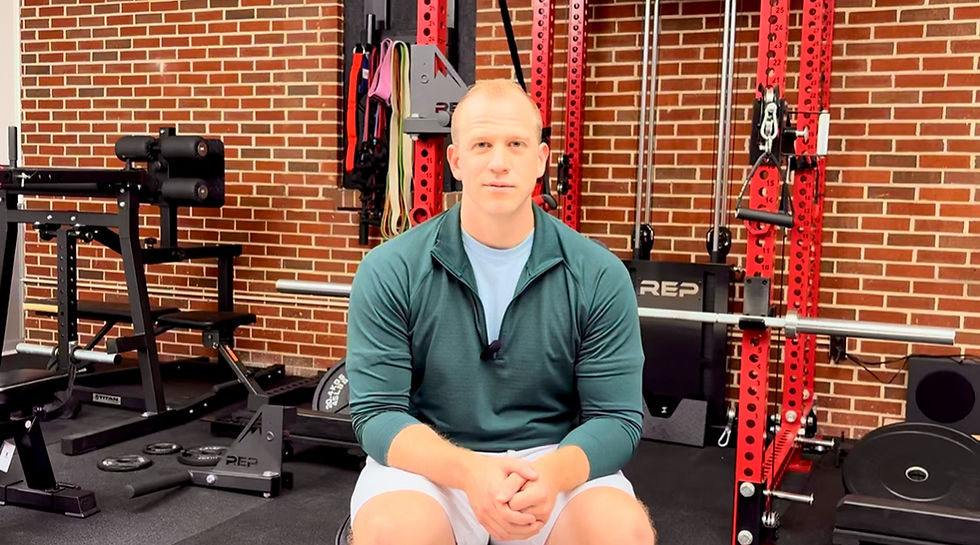Ground Up Strength Through a Full Range of Motion
- sylvesterfitness

- Sep 9
- 3 min read
Mobility: The Missing Link to Strength and Longevity
Chronic low back pain is insanely common. So are cranky knees, shoulders that pop and crack, and hips that always feel tight. Too many people accept these issues as “just part of aging.” But the truth is: it’s not aging — it’s regression. Your body is losing capacity because you aren’t addressing the real problem. And most of the time, the problem is mobility.

What is Mobility?
Most people think mobility just means flexibility. That’s why, when pain shows up, the instinct is to stretch the same muscle over and over. But tightness often isn’t a flexibility issue — it’s a strength issue.
When a muscle is too weak to handle the demands placed on it, it feels “tight” because it can’t support itself. The solution isn’t endless stretching. The solution is strength through a full range of motion. That’s what true mobility is.
This matters because anyone can feel strong when the joints are locked and everything is close to the body’s center of gravity. But real life isn’t like that. Mobility allows you to absorb force, control your body under load, and move freely without pain. It means you can squat deeper, twist further, and move with more control — all while preparing your body for the next stage of life.
Why People Skip It
Mobility isn’t “sexy.” It doesn’t look cool on Instagram. Often it feels awkward — like a series of goofy movements that don’t deliver instant gratification.
That’s why most people ignore it until pain forces them to pay attention. By then, you’re already behind and trying to catch up instead of building a foundation that would’ve prevented the issue in the first place. Mobility done proactively is like strength training’s insurance policy: it makes you stronger today while keeping you healthy for years to come.
The Longevity Connection
If your body is strong through a wide range of motion, you’re far less likely to get hurt when life surprises you — whether that’s slipping on the ice, missing a step, or reacting to a quick change of direction.
Falls are one of the leading causes of injury as we age, and recovery takes longer the older you get. A single accident can set off a chain reaction: injury, months of physical therapy, lingering weakness, and the feeling that things “never quite got back to normal.”
I hear versions of this story all the time. But when you build mobility, you don’t just bounce back faster — you reduce your chances of injury in the first place.
Mobility in Daily Life
Most people come to me with goals like losing fat or building muscle. But when you dig deeper, the real motivation is often about quality of life. They want to play with their kids or grandkids, travel without pain, or keep up with their family during active outings.
Mobility makes that possible. It means you can get down on the floor and back up easily. It means picking up and holding a child without shoulder or back pain. It means walking through an amusement park for hours and still feeling good. In short, mobility ensures you don’t get left behind in the moments that matter most.
Simple Drills to Get You Started
Here are a few quick mobility moves you can add to your warm-up or daily routine:
Sumo Squat Stretch
Start in a bent-knee toe-touch position, holding your feet.
Drop into a deep squat, keeping your elbows inside your knees.
Use your elbows to gently push your knees outward.
Hold a deep breath, then lift your hips high and stand tall.
Repeat 5 times.
Downward Dog to Cobra Flow
From a push-up position, push your hips toward the sky.
Drive your heels down and press your chest through your arms (Downward Dog). Hold for 5 deep breaths.
Shift forward, letting your hips sink toward the floor, chest lifted tall (Cobra). Hold for 5 breaths.
Flow between these two positions 5 times.
Thread the Needle
Start on hands and knees.
Inhale, then reach one arm to the sky.
Exhale as you “thread” that arm under your body, rotating your spine.
Hold for 10 seconds.
Repeat 3–5 times per side.
Takeaway
Mobility isn’t optional — it’s the foundation for strength, longevity, and staying pain-free. Whether you add one drill or a full routine, commit at least 5 minutes to mobility in every workout. If you don’t have a routine yet, this is the perfect place to start.
Because the truth is, strength without mobility is fragile. But strength with mobility? That’s what allows you to keep training hard, living fully, and enjoying every stage of life.



Comments